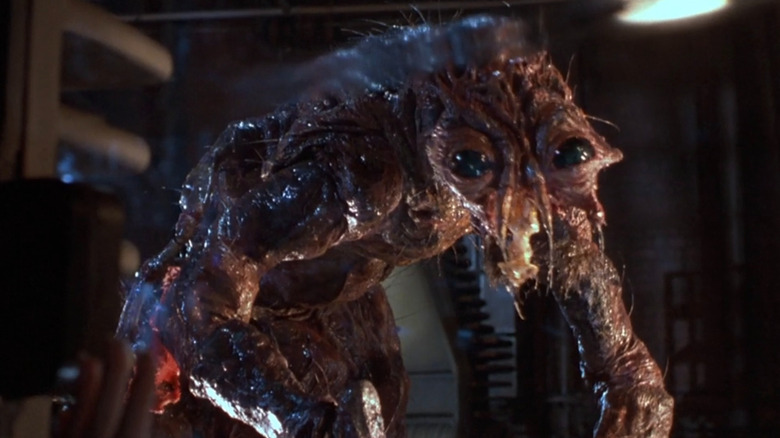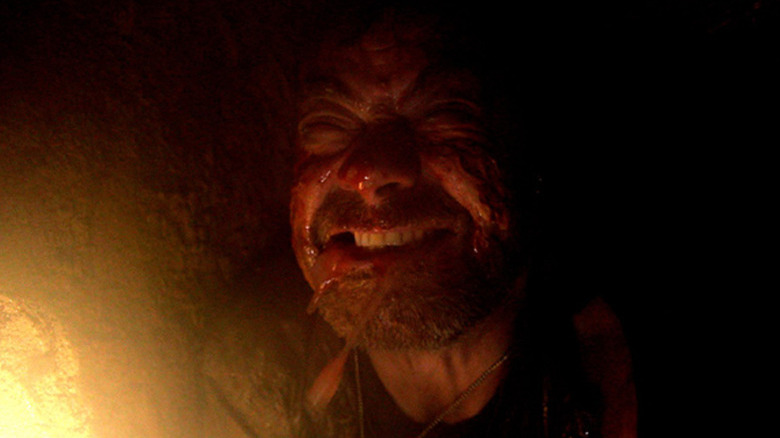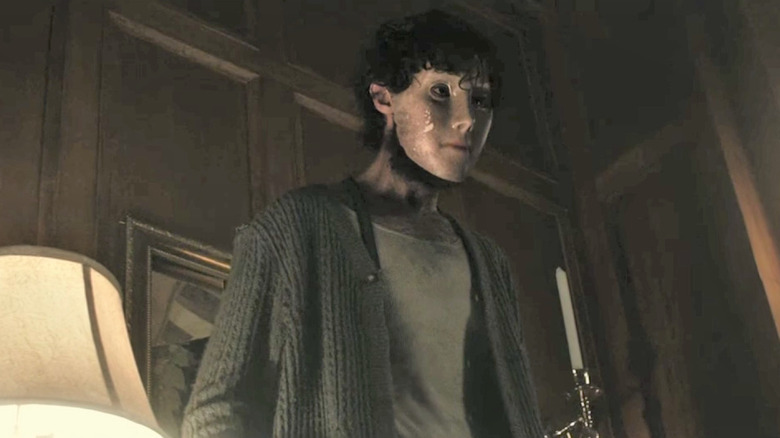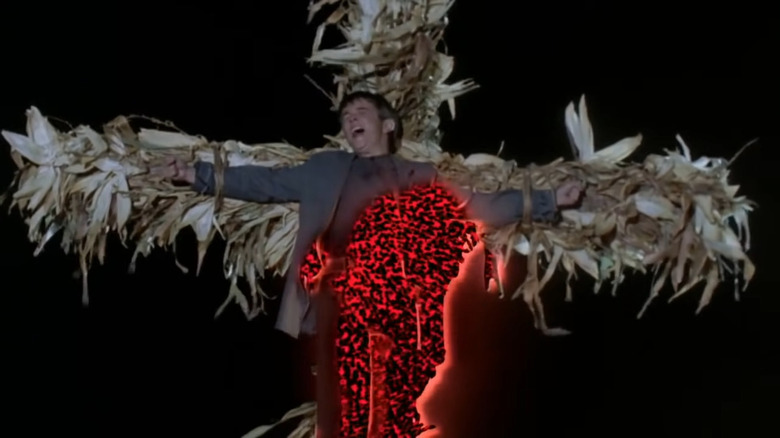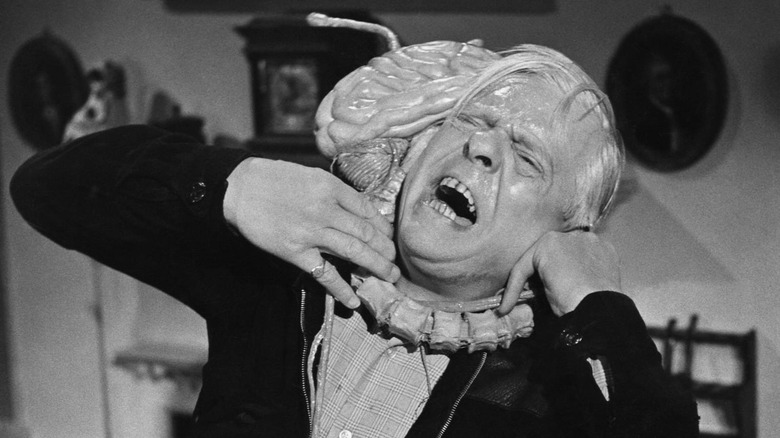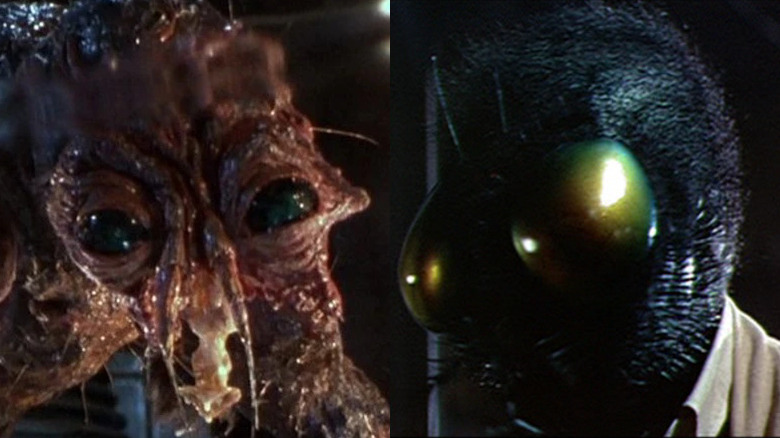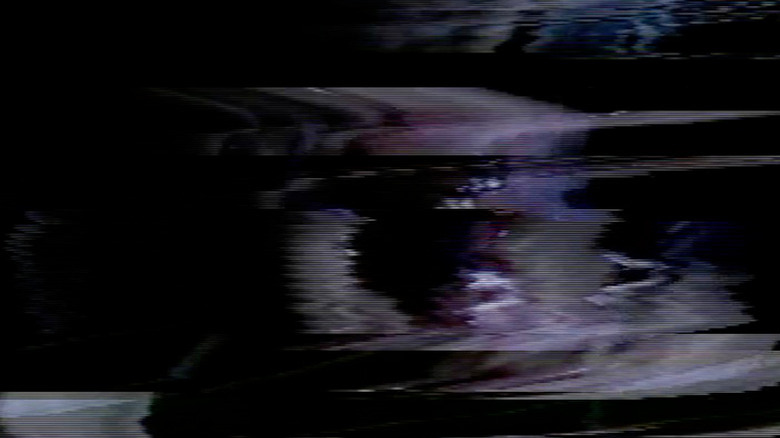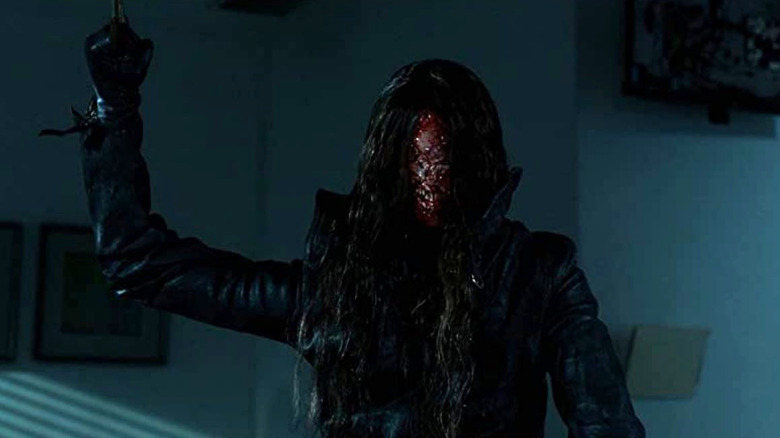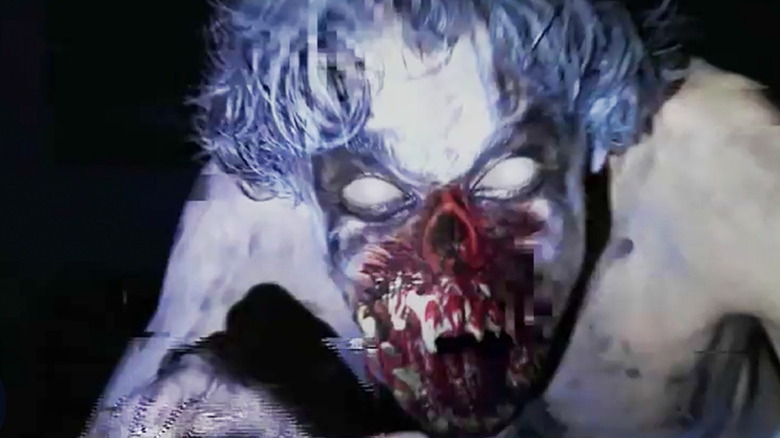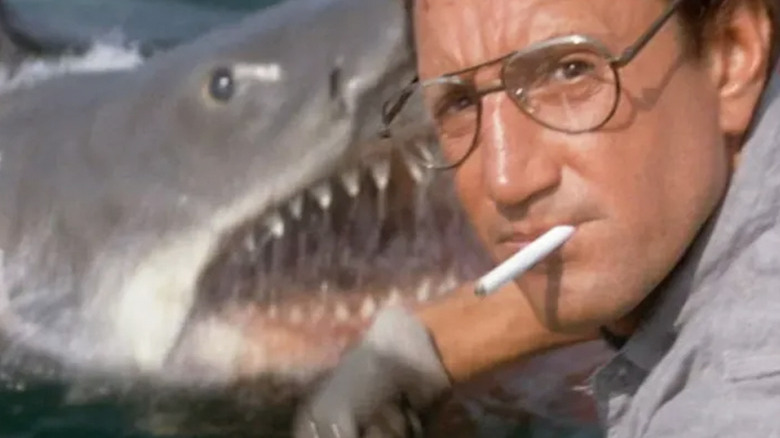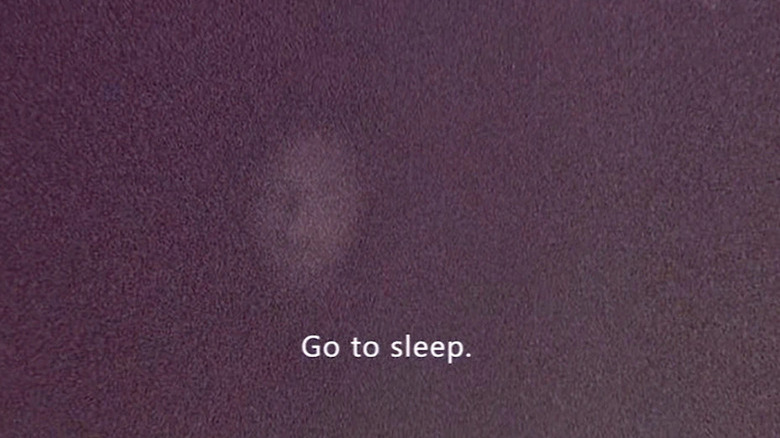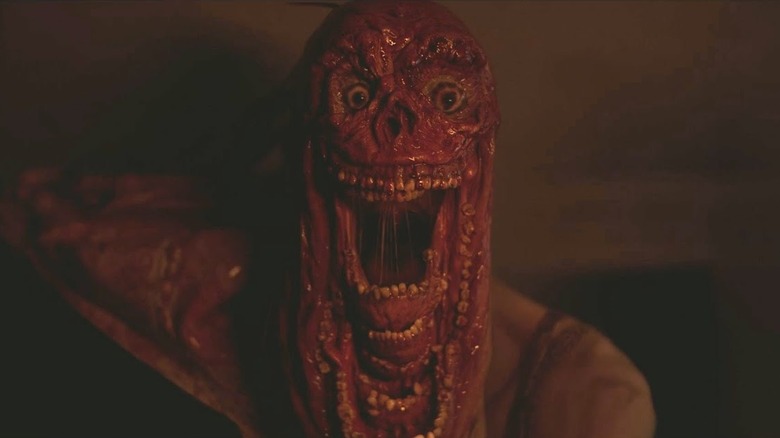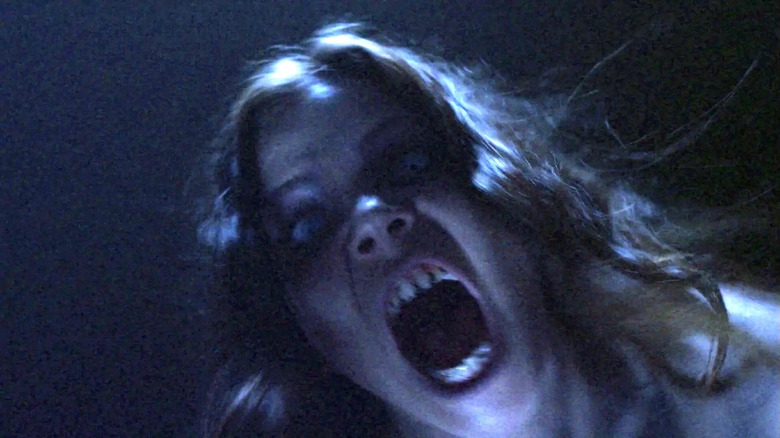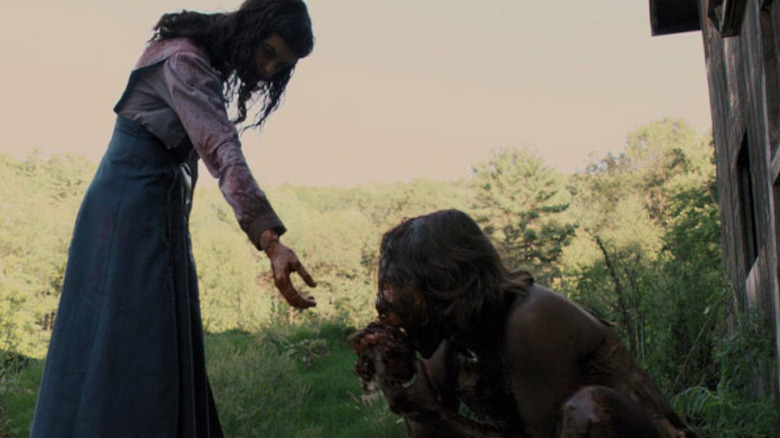13 Horror Movies Where You Don't See The Monster Until The End
Sometimes less is most definitely more, especially when it comes to horror films, a genre based around producing intense reactions in viewers. Horror is very similar to comedy, in that much of the film is predicated on a setup being followed up by an eventual payoff. This is especially true when it comes to how many horror films choose to reveal the main monster or killer that the story is focused around. Some films choose to show their monster right away, while others save the reveal for at least the halfway point.
Very often, however, the filmmakers will choose to wait until the proverbial 11th hour before revealing the monster. This will range from the very start of the film's third act to even the final seconds of the film, and it can often result in a stellar reveal that leaves audiences reeling, or in some cases, turn a film's once-promising climax to an underwhelming disappointment. So try not to let the suspense get to you, because these are 14 horror movies where you don't see the monster until the end.
The Borderlands
"The Borderlands" plays a sinister little game with its audience, lulling you into a gloriously false sense of security. This is truly one of those movies where, despite the rest of it being very well made, the last few minutes truly make it worth the watch.
The story, told via found footage, is interesting if standard: a trio of men working for the Vatican — Deacon (Gordon Kennedy), Gray Parker (Robin Hill) and Father Mark Amidon (Aidan McArdle) — are tasked with investigating a church in the Devon countryside. During their initial site check and setup at the church, they are told by the priest, Father Crellick, that a miracle has occurred. Throughout the film, the men witness bizarre and horrific activity in and outside of the church, including ghostly voices and children setting sheep on fire. It's soon revealed that the church was built on the remnants of a pagan temple that was used for ritualistic sacrifice to an evil entity.
It's in the film's closing moments, when Deacon and Gray descend into the church's depths, that they finally meet the monster. While searching for answers, they soon find themselves in the belly of the beast — and we mean that quite literally. The duo traverse a cramped, dark tunnel before the entrance disappears, trapping them inside of what's revealed to be the entity's stomach. On cue, stomach acid begins dripping from above, causing Deacon and Gray to scream in agony as they are slowly digested.
The Boy
"The Boy" is a prime example of a film with an admittedly intriguing setup that sadly runs out of gas in the homestretch — which is a shame because the film is far from horrendous, even boasting some decent suspense and solid performances.
The film follows Greta Evans (Lauren Cohan), a babysitter hired by an elderly couple known as the Heelshires for a special job. It seems that they need Greta to look after their son, Brahms, while they are away on holiday. It's quickly revealed that Brahms is nothing more than a child-sized porcelain doll with a mile-long stare. Despite the oddity of the job, Greta accepts and even agrees to the Heelshires' odd rules — including reading to Brahms and playing him loud music. Like any sane person, she ignores the rules, until things start getting spooky and Brahms seemingly starts moving on his own.
It isn't until the final act that the underwhelming truth is revealed — the real Brahms is actually the Heelshires' mentally disturbed son, living in the house's walls after a fire many years earlier. This is a shame, as any suspense or intrigue built up until this point is immediately drained out of the film. The trope of the horror being hidden in the walls has become a cliche for many, even subject to parody by the likes of Red Letter Media.
Children of the Corn
Stephen King's writing, even at its most baffling, still manages to conjure up an impressive amount of entertainment value. Case in point: the 1984 cinematic adaptation of his short story "Children of the Corn" is far from the strongest King outing. Yet the film still delivers ample amusement, not just from its few genuinely disturbing moments, but its unintentional hilarity.
The story centers on a couple, Vicky (Linda Hamilton) and Burt (Peter Horton), who find themselves stuck in a desolate town in the middle of rural Nebraska. Unfortunately this town is currently under the control of Isaac (John Franklin), a disturbed youth, and his second-in-command, Malachai (Courtney Gains). Through Isaac's indoctrination, they have created a cult of children who, three years prior, saw fit to murder all of the adults in town. This seems to be in service of an evil being that Isaac only refers to as "He Who Walks Behind the Rows."
It isn't until the end of the film that we're finally shown this evil being in a clunker of a reveal. As Isaac is betrayed by Malachai and strapped to a makeshift cross, an embarrassing-looking red energy effect envelopes his body. We later see this red electrical vomit spreading across the corn field, confirming not only that this is "He Who Walks Behind the Rows," but that this is one of the rare times that holding the monster's reveal until the film's conclusion might not have been the best move.
Fiend Without a Face
The 1950s were a glorious time for science fiction and horror, with a siege of onscreen monsters both memorable and, in many cases, hilarious. From giant spiders to wasp women to crawling eyes to killer trees, the Atomic Age was a time of phenomenal onscreen camp. However, amidst all the foam rubber hilarity, there existed some films with not only intriguing setups but some above-average monsters as well.
"Fiend Without a Face" centers around a group of people under attack from invisible entities that feed on human brains and spinal cords. They are eventually revealed to be the byproduct of a scientist's experiment to move the pages of a book with telekinesis. This creates a unique enemy that the characters are nearly helpless to defeat, as for most of the movie, they can't see them. That changes when a dose of nuclear radiation reveals the creatures as sentient brains with antennae, pushing themselves via their spinal column tails.
A major highlight of this 1958 film is that whenever the brains are shot, they sputter and spit out a slimy-looking, tar-like blood. For a movie this old, it's an impressively violent effect and a surprisingly gruesome concept for a time when film censorship was far more stringent. As a humorous Easter egg, the brain fiends were later referenced in the "Area 52" sequence in the Joe Dante-helmed "Looney Tunes: Back In Action."
The Fly, both versions
This is a rare instance of a film and its remake both doing the same type of monster reveal but in radically different ways. "The Fly," both the original from 1958 and the remake from 1986, tells the story of science gone illicitly unchecked. Both films share the same basic plot, though with very different tones and executions.
In both cases, we're introduced to the concept of a teleportation device, created respectively in both versions by André Delambre (David Hedison) and Seth Brundle (Jeff Goldblum). While testing the capabilities of their breakthrough inventions, both men accidentally have their DNA spliced with that of a housefly. In the case of the 1958 version, André's change is instant, forcing him to cloak his arm and face with towels. However, in the 1986 version, Seth's transformation is gradual, beginning with strange skin afflictions and eventually progressing to deformed flesh and mutating appendages.
But both films are similar in that you never see their final fly form until the film's closing moments. In the '58 version, André's head has been replaced with that of a fly, complete with a trippy multi-lens shot replicating insect vision. In the '86 version, Seth's jaw is ripped off, triggering his sickening metamorphosis into his ultimate fly form.
Ghostwatch
"Ghostwatch" doesn't have a typical monster — in fact, the film itself is a true oddity that isn't even like other horror films. Along with its long-maintained cult status, "Ghostwatch" has been cited as a major influence for a few found footage horror projects. In fact, the found footage film "Host" was reported to have taken a few cues from the slow-burn British horror classic.
The film is actually a faux broadcast made to flow and feel like an actual BBC-produced television event regarding the legitimacy of the supernatural. This means onscreen appearances from real-life BBC television figures, such as Michael Parkinson, Sarah Greene and even Craig Charles, best known for playing Dave Lister on "Red Dwarf." Greene is broadcasting live from a suburban home wherein the family claims they are dealing with a ghost they call Mr. Pipes or just Pipes. Throughout the film we're given only the briefest of glimpses at Mr. Pipes, never quite being able to distinguish his appearance for more than a second or two.
It isn't until the film's haunting final moments, when the broadcast goes sideways, that we are shown a more definitive look at him. We also learn that the clever Mr. Pipes has used the BBC's broadcast as a widespread ritual to haunt others across the country. The film chillingly ends with Parkinson, all alone, wandering an empty BBC studio, likely possessed by Mr. Pipes as the movie ends.
Malignant
We're truly living in a magical time for horror cinema, especially if we can expect more unbridled insanity like James Wan's "Malignant." The film follows Madison (Annabelle Wallis), a woman who finds herself plagued with visions of graphic murders following the death of her husband. As reality begins to erode for Madison, we are slowly shown more and more of the figure behind the killings, Gabriel. Aside from the black clothing and the long hair covering his face, the figure is only identifiable through his sinister voice. Also, whenever Gabriel runs, it almost looks as if he's somehow running backwards, and able to contort his body in strange ways. Gabriel and Madison seem to share some strange psychic connection, with her mind completely open to his influence.
However, in a twist bordering on science fiction, Gabriel is revealed to be Madison's conjoined evil twin, currently residing in the back of her skull. This is not only revealed via VHS flashback, but when a detained Madison suddenly has a seizure in the precinct's holding cell. Gabriel then emerges from the back of her head, much to the horror of her comical cellmates, who end up graphically butchered. A truly far-out idea for a horror villain, Gabriel serves as the perfect third act reveal for "Malignant."
Host
When COVID-19 shut down the film industry in 2020, some filmmakers opted to take advantage of the unique creative constraints. One such creator was Rob Savage, who — inspired by a successful found footage prank video — opted to make a movie set during a pandemic Zoom call. "Host," clocking in at less than an hour, shows a group of friends engaging in a socially distanced seance to stave off lockdown boredom. However, while conjuring a force from the other side, one of the girls' shenanigans results in an evil spirit coming through.
The group is soon picked off one by one, each one's demise more brutal than the last — until the herd is eventually thinned out to just two girls, Jemma (Jemma Moore) and Haley (Haley Bishop), the former even breaking quarantine to check on Haley at her home. As the clock representing Zoom's time limit ticks away, the duo light the way using a Polaroid flash, with the camera's final flash revealing a horrific-looking monster just as the Zoom feed cuts out.
Jaws
To this day, the line, "You're gonna need a bigger boat" is arguably one of the most famous movie quotes ever uttered and not without good reason. "Jaws" is not only one of the original cinematic blockbusters, but it also showed how you can turn a production negative into a positive.
It's been well-documented that the mechanical shark used in Spielberg's 1975 classic was a nightmare to work with. This is why, barring a few scant glimpses, the shark doesn't actually show itself until the film's halfway point, becoming more prominent throughout the film's third act. This is circumvented by literally putting us in the shark's point-of-view, letting us see through the eyes of the aquatic predator. However, when it finally does show itself, it's an absolute doozy and makes for one of the film's most effective moments. Who could forget the iconic moment when the shark lunges out of the ocean as Chief Martin Brody (Roy Scheider) is chumming the waters?
Despite the restraints of the mechanical shark, the effect is still very impressive, even 40 years after the film's original release. It's a movie monster that's just as scary whether it's looming underneath the water or is violently ripping apart a fishing boat.
Skinamarink
Adored by analog horror aficionados on TikTok and loathed by everyday moviegoers, calling "Skinamarink" a divisive film would definitely be an understatement. Regardless of your thoughts on it, there's no denying that this low-budget, lo-fi horror hit certainly turned some heads during its release.
Directed by Kyle Edward Ball, the film follows Kevin (Lucas Paul) and Kaylee (Dali Rose Tetreault), two little kids who wake up one night to discover things aren't right. Not only is their father missing but all the exits and windows to the outside world have vanished, leaving the siblings trapped. With nothing else to do, they set up camp in front of the television for days, just watching old cartoons. However, things get even more forbidding when a sinister disembodied voice begins beckoning to the both of them to "come upstairs." Eventually, the thing claims Kaylee after removing her mouth and eyes in one of the film's biggest scares.
In the film's closing scenes, an isolated Kevin is tricked by the entity into stabbing his own eye socket. Following this, we are informed through a subtitle that Kevin has been at its mercy for 572 days total — almost a year and a half. As the film concludes we are finally shown the entity as a vaguely distorted white face peering through the film's fuzzy darkness. In a film largely predicated on copious amounts of nothing happening, this definitely stands out as a disturbing visual.
Smile
2022 was a year rife with some exceptional additions to the horror genre, but none with marketing quite like "Smile." Who could ever forget the image of people with Cheshire Cat smiles standing in the background during Major League Baseball games?
Directed by Parker Finn, the film follows Rose (Sosie Bacon), a psychiatrist who, after the graphic suicide of a patient, finds herself in the crosshairs of something sinister. Now everywhere Rose goes she sees people with creepy, unflinching smiles identical to the one her patient had before she took her own life. The source of her nightmarish situation is eventually revealed to be an entity, referred to by the creators as Lollipop on the Blu-ray commentary, that feeds on mental trauma.
While the movie teases us about what Lollipop looks like through some drawings and Rose's increasing hallucinations, it isn't until the closing scene that we're finally shown Lollipop in all of its glory, a towering humanoid with pale skin, long hair, and sunken eyes. After cornering Rose, it peels back the skin on its face to reveal a monstrous, bloody visage with several rows of twisted teeth. It then lives up to its nickname, squeezing inside Rose through her mouth, just like a lollipop.
If you or anyone you know is having suicidal thoughts, please call the National Suicide Prevention Lifeline by dialing 988 or by calling 1-800-273-TALK (8255).
Unfriended
Cyber horror — sinister tales that utilize the terrors of the internet — has been becoming increasingly more frequent since its inception. "Unfriended" is a film that, while a bit hollow in terms of characters, takes full advantage of its bizarre format.
The film is told through the desktop of Blaire (Shelley Hennig), a high schooler in the midst of a group Skype call with her boyfriend and extended friend group. However, there is an unknown participant that the group at first dismisses but is made aware of very quickly. Eventually they link the account back to Laura Barns (Heather Sossaman), a classmate of theirs who took her own life after a viral video of her passed out at a late-night party, drunk and having soiled herself, was circulated online. Armed with shameful truths about each of her former classmates, Laura's cyber ghost begins wrecking bloody vengeance on them.
It isn't until the very end of the film when Blaire, the last one left standing, is finally claimed by the ghost. In a frighteningly jarring moment, the laptop feed is violently shut and a demonic Laura erupts from the darkness as Blaire screams, ending the film.
The Woman
Despite what the poster for "The Woman" might have you believe, the film itself contains several monsters, just not the ones you'd suspect. The film is actually a sequel to an even lesser-known film titled "Offspring," in which we meet the titular Woman, played by Pollyanna McIntosh. Upon first glance, you'd immediately and not unfairly assume that this feral, blood-covered woman is the antagonist. That isn't so, as the film actually focuses on the Woman being brutally domesticated by the Cleeks, a seemingly normal family hiding many dark secrets.
Not only is the father, Chris (Sean Bridgers), an abusive sociopath, but his son, Brian (Zach Rand), is a complete sadist in his own right as well. This means that life is frequently hell for Chris' poor wife, Belle (Angela Bettis), and his two daughters, Peggy (Lauren Ashley Carter) and Darlin' (Shyla Molhusen). We're continually shown and told throughout the film that the children are tasked with feeding the family's dogs. At one point, we're even shown the point-of-view from one of the more rabid "dogs" while Brian is feeding it.
During the film's shocking climax, the father and son feed Peggy's teacher, Ms. Raton (Carlee Baker), to the dogs. It's then revealed that the point-of-view we saw earlier isn't from a dog, but rather Chris's other daughter, Socket, a feral girl with no eyes. We're then treated to a sickening sight as the disfigured and mentally broken Socket proceeds to rip the helpless teacher to pieces.
